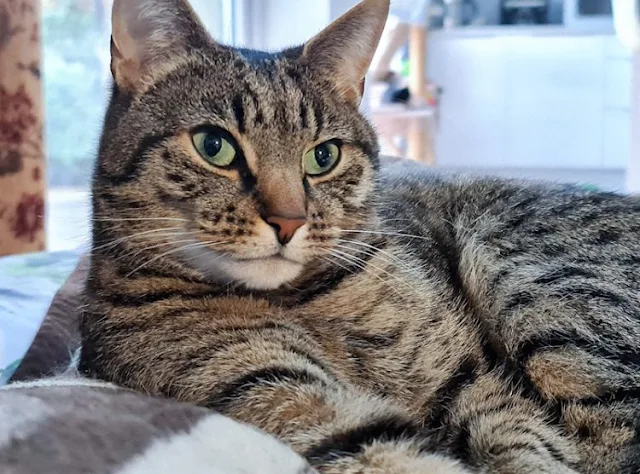It is no surprise to me that Jackson Galaxy, the world's most famous cat whisperer (cat behaviourist) dislikes or is disappointed with cat breeding and the breeds. Well, I have generalised and read his mind so I'll tell you what he says in his book Total Cat Mojo about the purebred cats and you can make up your own mind.
He always adopts non-purebred cats. He does the right thing. Although he is high profile, he's very down to earth and a realist. He sees the big picture and the need to do the right thing and adopt rescue cat. He worked extensively in cat rescue before becoming a famous cat bebehaviourist.
 |
| Jackson Galaxy loved Barry deeply and misses him a lot. Photo: Jackson Galaxy. |
He heads his section on breeding and the breeds with "The Puppet Master Enters: Purebred Cats".
You get a hint in that heading. He's saying that people are playing at God when they create new purebred cat breeds and create them for sale.
He explains that in the early days of the cat fancy there was no extreme breeding as there is today. For example, he explains that the Siamese cat's pointed coat was enough to distinguish that cat breed from the rest and it was and still is.
And the Persian cat back in the old days was pretty much a standard-looking cat. There were no flat-faced oddities in those days. This is what he says. But today "breeding is an altogether different beast (so to speak), with organisations recognising anywhere from 44 to nearly 60 different breeds of cats (I think actually that TICA recognise more than 70)."
And he then goes on to talk about how the cat fancy developed in America in a detrimental way. He says:
"In the process, we have pushed cats' physical appearance to extremes, often without regard for the well-being of the cats being bred. We've made the Persian's face flatter and the Siamese space thinner and more pointed. Consequently, the changes we have imposed through breeding are in many ways detrimental to the Raw Cat."
The Raw Cat that he refers to is the natural domestic cat, the domesticated wildcat with a wildcat character beneath that domestic exterior.
He adds that:
"By selecting Persians for the brachycephalic (short-nosed) appearance, we have actually made it harder for them to breathe, increased the chance of skin, dental and eye disease, and made giving birth riskier and more difficult.
Scottish Folds are used as a model for studying pain and arthritis because the mutations that cause the folds in their ears also lead to painful degeneration in their bones and cartilage.
Manx cats are prone to back pain, constipation, and other elimination problems because of spinal cord deformities.
Maine Coon cats are prone to heart disease, and Siamese cats have a higher likelihood of asthma and hyperaesthesia. Sidebar from Michael: the modern Siamese is the unhealthiest breed and the Persian is in the top three.
RELATED: Siamese: The World’s Most Unhealthy Cat!
These are just a few examples. When you limit the gene pool, you increase the chance of dangerous mutations and disease. There is no other way around it.
Humans may be pulling the strings when it comes to cats' exteriors, but are we making any progress in understanding their inner world?"
As you can see, he is critical of a section of the cat fancy where they breed purebred cats to extreme meaning the anatomy becomes abnormal in order to create a cat which looks different and can be completely distinguished from the other breeds.
The objective here is to sell more cats and to follow the breed standard accurately but breeders go beyond simply following the breed standard in their efforts to create more interesting cats at which point they create unhealthy cats as is emphasised by Jackson Galaxy.






